(la traduction de la première partie est maintenant disponible)
(la traduction de la deuxième partie est maintenant disponible)
(troisième partie) (uniquement en français)
[MàJ - Dimanche 16 juillet 2006] Suite de l'aventure...
Avec le buzz qui est en train d'enfler autour de la présentation de Google aux analystes financiers, le 2 mars dernier, l'occasion est trop belle pour ne pas tenter de reconstituer l'introduction faite par Eric Schmidt, PDG de la firme.
Outre la version officielle en PDF de Google, nous disposons en effet d'une version PPT du fichier, opportunément sauvegardée par Tomy Lorsch, et des notes laissées par inadvertance, très opportunément sauvegardées par Derrick, il n'y a donc plus qu'à remettre les notes à leur place, à les associer aux diapositives qu'elles commentent, et à les traduire (tout au moins l'essentiel)...
En effet, s'il y a des diapos dont la compréhension est immédiate, d'autres sont plus difficiles à appréhender sans les commentaires, et d'autres encore impossibles à saisir sans les explications (la 9 et la 10, par exemple).
Or vu que la traduction va quand même me prendre un peu de temps et que je n'ai pas que ça à faire, je traduirai une diapositive après l'autre, ça prendra le temps que ça prendra !
À toutes fins utiles, j'ai demandé à Matt Cutts s'il pouvait me conseiller sur le meilleur moyen d'obtenir l'autorisation de Google pour cette traduction. En attendant, s'il y en a qui veulent commenter, toutes vos remarques seront les bienvenues. À +...
Diapositive n° 2 - La mondialisation
Diapositive n° 3 - Les grands problèmes
Diapositive n° 7 - Leader de la recherche
Diapositive n° 8 - Piloter l'innovation dans la recherche
Diapositive n° 9 - Un système publicitaire plus exhaustif
Diapositive n° 10 - La vache et la sagesse collective
Diapositive n° 11 - Un système publicitaire plus exhaustif (suite)
Diapositive n° 13 - Résoudre les grands problèmes
Diapositive n° 14 - Les services et les produits aux consommacteurs
Diapositive n° 15 - L'évolution de Google
Diapositive n° 16 - Davantage de détails sur les plateformes mobiles et le marché global
Diapositive n° 18 - Les 7 grands volets
En trois formules :
- celle que je préfère : la diapositive n° 10
- celle qui me laisse perplexe : la diapositive n° 9
- la plus éclairante : la diapositive n° 18
- GDrive et Lighthouse, diapositive n° 14
- Teragoogle, diapositive n° 7
* * *
Diapositive n° 2 – La mondialisationDiapositive traduite
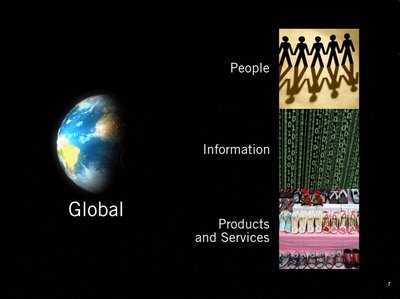
So what I thought I could do today is talk about how we think about these very big shifts in media and advertising. And let's just be candid here – there aren't just big shifts in the industry, there are some pretty big problems and challenges facing every significant player in the ecosystem. And the way that we at Google think about these problems is a little different from lots of the other ways that people think about things.
One way to think about it is that Google set itself out to work on problems that involved people – problems that mattered about information at scale – building products and services for the whole world.
I'm a computer scientist. I don't have the media and marketing backgrounds that you all do, so I look at the industry and how it's changing and think this is an opportunity for using technology to solve problems that have never been solved before… or never needed to be solved, until now. [Début]
Diapositive n° 3 - Les grands problèmes
Diapositive traduite
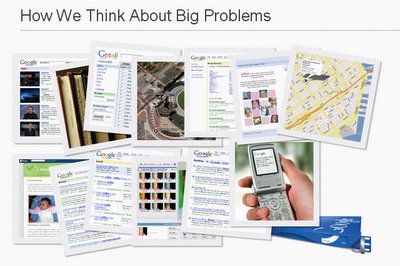
We have some basic guidelines we use to solve big problems -
We try to identify when our technology can solve an existing problem at worldwide scale.
Google is important to the world and we use that to advantage:
We tackle important problems people really care about
We address large markets with big opportunities
We will make sure everything and everyone has access to Google
Its clear to us that we are just at the beginning of meeting our mission of "Organizing the worlds information and making it universally accessible and useful” We believe that we have less than 5% of the information we should be able to get into our indexes, and we believe that the technologies we will develop will significantly expand the definition of search and the scope and scale of our worldwide business.
For example,
. Video and Print – filling a void in our search products and making sure Google Search has high utility; increasing time users spend with Google; building a competitive advantage in information acquisition and storage; can ultimately lead to niche, extremely targeted/valuable advertising opportunities
. Gmail – reinventing email management; email is where consumers spend an inordinate proportion of overall time online
. Picasa – provide better organization for our digital lives and with the release of online photo management, organize/store more of our important/cherished data with Google
. DesktopSearch – provide high utility and make the access via Google of public and personal information seamless
Think of Google “as ubiquitous as brushing your teeth.”
With 56% of Internet search referrals, Google is the world’s largest search engine.
We are spending 500m+ in CapEx and innovating in products like automatic machine translation in order to make this happen.
We’re taking this learning to advertising and reaching end users... [Début]
Diapositive n° 7 - Leader de la recherche
Diapositive traduite
 As the market leader, we need to ensure search doesn’t become a commodity. Our focus on search is nothing new. We built our brand on being the best search engine, with the best results, and as our competitors have caught up to us, it’s become even more important for us to focus on:
As the market leader, we need to ensure search doesn’t become a commodity. Our focus on search is nothing new. We built our brand on being the best search engine, with the best results, and as our competitors have caught up to us, it’s become even more important for us to focus on:1) Speed
•Solve international speed issues and bring international users to US performance
2) Comprehensiveness and freshness
•“All webpages included in the Google index and searched all the time” – Teragoogle makes this possible
•Expand to other sources of data
•Become the leader in geo search (any search with a geographic component).
•New forms of content – video, audio, offline printed materials
3) Relevance
•Leverage implicit and explicit user feedback to improve popular and nav queries
•Introduce new personalization elements
4) User Interface
•Experiment with several new UI features to make the user experience better [Début]
Diapositive n° 8 - Piloter l'innovation dans la recherche
Diapositive traduite
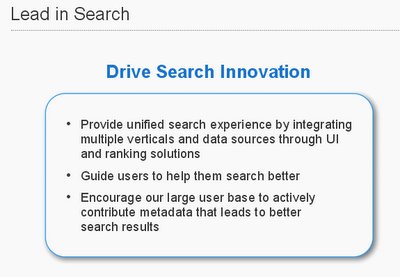
To really make good on that last part – improving the user experience, we need to drive search innovation.
For example, we need to provide unified search experience by integrating multiple verticals & data sources through UI and ranking solutions
•Add features, not properties and make it really easy to use
Guide users to help them search better
•Make query interpretation transparent through UI elements and help users refine queries
Encourage our large user base to actively contribute metadata that leads to better search results
•Wiki of search: empower users/experts to improve search results in their domains of expertise — create a million verticals
•Effectively integrate user feedback (ratings, comments, tags) into search [Début]
Diapositive n° 9 - Un système publicitaire plus exhaustif
Diapositive traduite
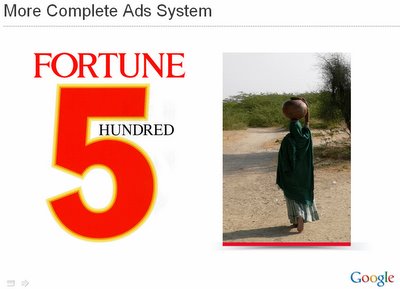
Now let’s look at another core element of our business: advertising. Consider that today, 1 in 4 retail dollars is spent online, and you’ll immediately understand the tremendous opportunity before us.
Our ads business for the moment is healthy and growing and we’re on a strong trajectory
•projected to grow from $6bn this year to $9.5bn next year based purely on trends in traffic and monetization growth
But strong competitors are attempting to aggregate traffic
•AdSense margins will be squeezed in 2006 and beyond
•Y! and MSN will do un-economic things to grow share
•The ad network will be commoditized over time
So, we need to build a more complete ads system that is characterized by two words: wider and deeper. That is, cast the net wider to attract new customer types) and deeper to enhance our relationship with existing customers. [Début]
Diapositive n° 10 – La vache et la sagesse collective
Diapositive traduite
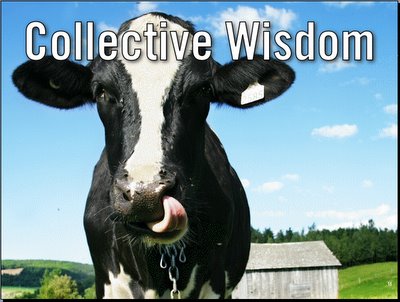
What does a cow have anything to do with this?
If you haven't read James Surowiecki's "Wisdom of Crowds," I highly recommend it. In the book, Surowiecki tells a story about an experiment done in the 19th century. It was by this British anthropologist named Francis Galton.
What Galton did in the experiment was go to a county fair where he had close to 800 people guess the weight of an ox by writing their guess on a slip of paper. Among the 800 or so people were a lot of ordinary county fair goers but there were also some experts – butchers, cattle farmers, you know, the sort of people who would have a reasonably good idea how much a particular cow should weigh.
The remarkable outcome of this experiment is that when Galton tallied all the guesses, the average guess, that is, the collective guess of the crowd was significantly better than the guess of any individual within the group. Think about that. The crowd was wiser than any individual, and that included the experts.
This principle has proven out over and over. And you see it everywhere: financial markets, political elections, and even the synchronization of traffic.
So let's go back to the Hustle and Flow graph I showed you earlier. But instead of just Hustle and Flow, think about every single piece of content ever created and owned by CBS. Now let me ask you a few questions – these are rhetorical:
* Do you know exactly how many assets you have? By assets, I mean all the content you've ever owned or created. Do you know exactly? Do you have the count? (Remember, I'm a computer scientist. I have to ask these things.)
* What percentage of your assets is currently available to users such that they can access it any time, view it, enjoy it any time? And I don't necessarily mean on Google Video, but it could be on your own web sites. What percentage? Pretty small?
* Now let's say you could suddenly make all your assets available to users worldwide. If this happened, do you know which of your assets would be most popular? Would it be last season's Survivor finale? Or would it be a segment from 60 Minutes that might have aired 10 years ago? Do you know which assets would be most popular in Miami vs. most popular in Ft. Lauderdale? Or in the U.S. vs. in Cambodia? Or on Wednesday mornings vs. Sunday nights?
Here's a fact that I've learned while at Google and I want to share it with you: a company is not smarter than the consumers of that company's products. [Début]
Diapositive n° 11 - Un système publicitaire plus exhaustif (suite)
Diapositive traduite

By Wider, we mean:
•Simplifying the experience and streamline advertiser acquisition for small and medium-sized businesses
•Developing a great branding product for large online advertisers and for offline advertisers of all sizes
•Expanding offerings to include print, radio, TV, and direct mails
By Deeper, we mean:
•Providing Advanced Tools & Reporting for sophisticated advertisers (e.g., API, bid management, ad scheduling)
•Expanding AdWords from clicks to conversions (e.g., Landing Page Optimization, Google Analytics integration)
•Tightening integration with other Google products (e.g., SiteMaps, GoogleBase, Local)
To really get down to brass tacks, we’re going to:
Execute well on our core ads projects to help us exceed the $9.5bn target (and backfill any AdSense partner loss) and drive advertiser satisfaction
•Simplification
•Quality initiatives (e.g. landing page quality)
•Fight hard to maintain share in the AdSense network
•Aggressive guarantees
•Increased monetization on existing pages
•Expand inventory rapidly through:
•Support for new ad formats
•Targeting other types of media
•Developing market-leading/”hit” Google properties and consumer applications
•Extend into adjacent SMB services (CBG is only a first step)
•Treat advertisers as full-fledged businesses with a broad set of needs (not just advertising)
•Ensure that we are not supplanted in the consumer buying cycle by eBay, AMZN, Yahoo in their effort to become one-stop shops in the full buying cycle
•By bringing more product information to Google (e.g. via Base)
•By providing users with a richer search experience (e.g. attribute search, vertical search, and richer product information and reviews)
•By leveraging CCC apps to provide users with the product/service information they care about when they want it [Début]
Diapositive n° 13 - Résoudre les grands problèmes
Diapositive traduite
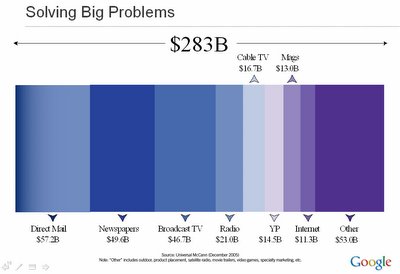
In the US alone, there is $250B spent in advertising. Is there a problem here? I’m guessing that the title of the day today has something to do with it – can you make $250B more accountable?
Accountability in marketing, having run another F1000 company, generally came from my Mom. I would spend $100M on TV ads and the only accountability I had was my Mom calling to say she liked the fish we used in our ads.
Appendix
The U.S. Advertising Marketing (2005E)
Internet is $11.3B, and of that Search advertising was $3.84B 2004 and projected to be $4.7 B 2005E
Source: Universal McCann, 12/05
Of this roughly $4B total search revenue; Google has 79% share, which is 27% of the total U.S. Internet advertising, or 1% of all U.S. advertising
Source: eMarketer February 2005, eMarketer May 2005; Note: U.S. Search – comparative estimates from 5 sources; U.S. Online – comparative estimates from 12 sources
Given current growth rates, online advertising will approximate the size of
cable TV today, in 2007; and online advertising will be the size of
radio advertising today, in 2009
Internet growth is the most aggressive, with cable the second most aggressive; other media are trying to keep single digit positive growth
Additional soundbites:
How long it took to reach 50M users of various media
Radio took 37 years to get to 50M listeners
TV took 15 years to get to 50M viewers
Cable took 6 years to get to 50M viewers
Internet took just 3 years to get to 50M users
And how long it took to reach $1B in advertising spending on various media
Radio took 45 years to get to $1B in ad spending
TV took 10 years to get to $1B in ad spending
Cable TV took 7 years to get to $1B in ad spending
Internet took just 3 years to get to $1B in ad spending
Source: Morgan Stanley Technology Research
"Other" includes outdoor, product placement, satellite radio, movie trailers, video games, specialty marketing [Début]
Diapositive n° 14 - Les services et les produits aux consommacteurs
Diapositive traduite
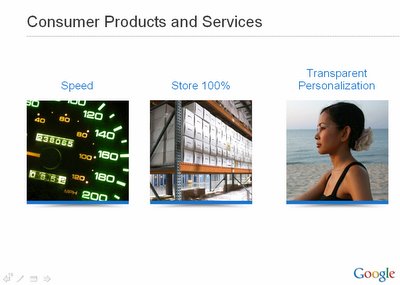
In a world with infinite storage, bandwidth, and CPU power, here's what we could do with consumer products…
Theme 1: Speed
Seems simple, but should not be overlooked because impact is huge. Users don't realize how slow things are until they get something faster.
Users assume it takes time for a webpage to load, but the experience should really be instantaneous.
Gmail started to do this for webmail, but that's just a small first step. Infinite bandwidth will make this a reality for all applications.
Theme 2: Store 100% of User Data
With infinite storage, we can house all user files, including: emails, web history, pictures, bookmarks, etc and make it accessible from anywhere (any device, any platform, etc).
We already have efforts in this direction in terms of GDrive, GDS, Lighthouse, but all of them face bandwidth and storage constraints today. For example: Firefox team is working on server side stored state but they want to store only URLs rather than complete web pages for storage reasons. This theme will help us make the client less important (thin client, thick server model) which suits our strength vis-a-vis Microsoft and is also of great value to the user.
As we move toward the "Store 100%" reality, the online copy of your data will become your Golden Copy and your local-machine copy serves more like a cache. An important implication of this theme is that we can make your online copy more secure than it would be on your own machine.
Another important implication of this theme is that storing 100% of a user's data makes each piece of data more valuable because it can be access across applications. For example: a user's Orkut profile has more value when it's accessible from Gmail (as addressbook), Lighthouse (as access list), etc.
Theme 3: Transparent Personalization
The more data, access, and processing Google can handle for the user, the greater our ability to use that data to transparently optimize the user's experience.
Google Desktop w/ RSS Feeds is a good first example: the user should not have to tell us which RSS feeds they want to subscribe to. We should be able to determine this implicitly.
Other potential examples: User should not have to specify the "From" address in Google Maps; user should not have to specify which currency they want to see Froogle prices in; user should not have to manually enter their buddy list into Google Talk. [Début]
Diapositive n° 15 - L'évolution de Google
Diapositive traduite
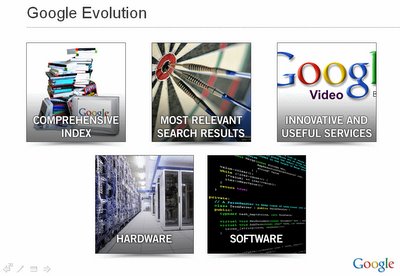
How we plan to use our past experience and advantages to help advertising………
Google’s strategy is built upon the same foundation as all of our products and services:
1) Lowest cost, highest performance hardware infrastructure
•New computing designs, communications and data center infrastructure
•100x better than industry network size
2) Worlds best memory-based software architecture
•Making programming easy and reliable on this new model
•Making execution as reliable as storage is today
•Making large scale computation made very easy
•Automatic and market-based machine allocation with real economics
This foundation and framework will enable Google to set new standards for innovation and comprehensiveness. We plan to:
• Get all the worlds information, not just some
• Crawl everything online (crawl and feeds)
• Use our distribution to get their information and also get it structured; make it easy to give to us
• Offer good tools for web masters to help understand their inclusiveness
• Expand to include other, new information: Video, Print, Photos. [Début]
Diapositive n° 16 - Davantage de détails sur les plateformes mobiles et le marché global
Diapositive traduite

In this context, mobile devices play a key role.
When you look at really important developing markets like India, China, Latin America, mobile phone penetration by far outpaces PCs and laptops. In these regions especially, we need to build products for the next billion users and build stronger relationships with mobile service providers to make sure people have access to them.
Consider this: 1 in 6 people in the world live in India
1/3 of the world's population is in China + India
4B people in the world have never made a phone call
This points to an extremely compelling need to localize our products and make them available and relevant to people who speak languages other than English, and who don’t have ready access to PCs.
Furthermore, 79% of Internet users are outside the US and 67% of them primarily speak a language other than English – the bottom line is we’d be doing our users and our company a disservice to not focus on making our products relevant and compelling to a non-American, non-English-speaking audience. [Début]
Diapositive n° 18 - Les 7 grands volets
Diapositive traduite
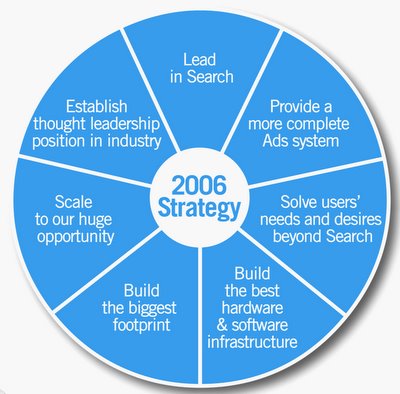
I’ll cover each of these areas in greater detail in this presentation, but our strategy can be divided into seven main themes that cover our entire business:
1) Lead in Search: Deliver on Search fundamentals, and innovate new Search models
2) Provide a more complete Ads system: Wider and deeper (best user experience and best ROI)
3) Solve users’ needs and desires beyond Search: Create, Remember, & Share
4) Build the best hardware & software infrastructure: Leverage our lead in hw and sw to our increased advantage
5) Build the biggest footprint: extend Google services to users wherever they are
6) Scale to our huge opportunity: hire the best, leverage bottom-up innovation, grow with core values intact
7) Establish thought leadership position in industry and beyond: work with extended partners, regulators, media and centers of influence [Début]
Traduction à suivre (si Google m'en donne la permission)...
Tags : Google, Teragoogle, GDrive, GoogleDrive, Google Drive, gdrive, Lighthouse, Internet, Web 2.0

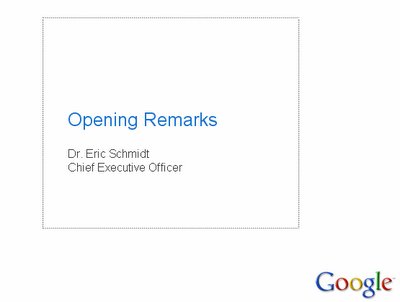
5 commentaires:
Bonjour,
« Au final de ce que j'en ai compris (c'est à dire pas grand chose, d'où mon commentaire), ça ressemble pas mal à du buzz, avec de jolies compos de présentation. du google qui commet des erreurs comme le commun des mortels. Peut être je me trompe, @+, je repasserai ;-) »
Tout d'abord, je précise que dans le cas présent, toutes les infos qui peuvent circuler autour de cette fuite créent sûrement du buzz, mais l'info en elle-même n'est aucunement une rumeur.
Ou alors on se demande pourquoi Google aurait publié un communiqué rectificatif auprès de la SEC, la très sérieuse commission américaine des opérations de bourse, signé par Eric Schmidt lui-même.
En fait, tous les commentaires à ces diapos sont à proprement parler une mine d'informations de première main qui n'auraient jamais dû sortir de chez Google, sinon en temps et heure. Disons qu'ils ont un peu brusqué les choses...
Pour l'instant je reste circonspect quant à la traduction, essentiellement pour des problèmes de copyright, mais je ne désespère pas de pouvoir m'y atteler pour pouvoir souligner au fur et à mesure les enseignements et la richesse de ces commentaires.
En tout cas, merci d'avoir été le premier à réagir. :-)
Jean-Marie
Mouais... tout ça est bien vague... Ce sont des objectifs tout ce qu'il y a de plus classique pour une société telle que Google... Je suis certain que Yahoo et MSn ont les mêmes...
De là à les atteindre, cette présentation en reste vraiment à un haut niveau d'abstraction.. On ne rentre jamais dans le détail, effectivement je suis certain que tout celà est un buzz orchestré.
Bref cette présentation nous ferait croire que Google prépare tout plein de trucs fabuleux mais en pratique, ça sera certainement différent et bien long...
Bonjour, ou bonsoir :-)
Parazine a écrit : « je navigue sous linux (Mand. 10.1) et il y a un script qui plante en page accueil de ton blog ;-) »
Euh, tu me parlerais chinois, je comprendrais pas plus. Ce blog, c'est Blogger, donc ce n'est pas vraiment moi qui peux intervenir. Maintenant, le script dont tu parles, c'est peut-être le javascript d'Alexandria (http://www.memodata.com/) qui permet en cliquant sur n'importe quel mot du texte de voir s'afficher la définition, la traduction, etc.
Si ce n'est pas ça, je donne ma langue au chat...
Quant à ma réponse à vos observations, j'ai besoin d'un ou deux jours pour l'argumenter, après avoir fait une synthèse des points saillants.
J-M
Google veut chacun de partager l'information, très bien.
Là où je ne vois pas bien c'est le rôle de la publicité, comme moyen pour Google de gagner de l'argent, en fonction du contenu de ce qu'on partage.
D'abord, la publicité ça encombre l'écran et ça peut empêcher de voir le contenu si ça envahit trop: je viens de désactiver Macromedia Flash player de mon navigateur à cause de cela.
Donc si pas (ou moins) de publicité, pas (ou moins) de revenu pour Google
Ou est le bug?
D'autre part, si je veux partager l'information dans un cercle restreint, comment Google me garantie que ce que je partage, mais garde restreint, ne va pas s'évader là où je ne veux pas que ça aille? De plus pour me proposer de la publicité sur ce contenu restreint, Google doit bien accéder à mon contenu, pour l'analyser et décider de la bonne pub à m'afficher. Donc Google ne peut pas me garantir contre son propre accès à mon contenu.
Par conséquent la proposition de Google, liée à la publicité, n'a de sens que pour un contenu qui peut être rendu public...
Google c'est peut-être beaucoup de dollars mais est-ce beaucoup de contenu?
Pour ajouter à la personne ci-dessus : la publicité ce n'est pas du tout de l'information ! C'est de la manipulation mentale à but lucratif... comme on le voit là : http://www.local.attac.org/paris19/article.php3?id_article=176
Enregistrer un commentaire